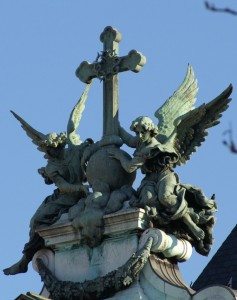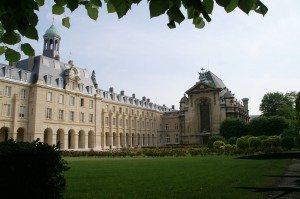(02 nov 2011) - Le jeudi 3 novembre, dans les salons de la Cité nationale de l’histoire de l’immigration à Paris, Benoît Magne, prêtre de la Compagnie des Prêtres de Saint-Sulpice et économe provincial, recevra, pour le groupe sculpté sur le fronton de la Grande Chapelle du séminaire Saint-Sulpice, le prix Chantiers du Cardinal décerné par le magazine Pèlerin dans le cadre de son concours annuel Un Patrimoine pour Demain.
Actuellement, la Compagnie de Saint-Sulpice, dont l'apostolat est la formation initiale et permanente des prêtres, a lancé un grand chantier de restauration, celui de la Grande Chapelle du séminaire Saint-Sulpice à Issy-les-Moulineaux, avec un soutien important des collectivités locales et le soutien inconditionnel de la ville d’Issy-les-Moulineaux. Plus de sept corps d’état sont à l’œuvre pour restaurer façades et vitraux.

La Compagnie a posé sa candidature au concours de sauvegarde d’art sacré Un Patrimoine pour Demain. en présentant la sculpture en bronze qui trône sur le fronton de la Grande Chapelle depuis 1901. L’assomption du monde sauvé par la Croix attire le regard de tous les Isséens d’où qu’ils soient. Ce groupe en bronze sculpté, emblématique de la Grande Chapelle, d’une hauteur de 3,30 mètres, d’une largeur de 3,80 mètres et d’une profondeur d’1,50 mètres, pèse près de trois tonnes. La restauration est confiée aux techniques éprouvées de la Fonderie de Coubertin à Saint Rémy-les-Chevreuse près de Versailles.
Comme l’écrivait en 1652 Jean-Jacques Olier, prêtre contemporain de saint Vincent de Paul et fondateur de la « petite » Compagnie, "La Sainte Croix, qui était auparavant l'opprobre [...] du monde, [...] est devenue, depuis la mort de Jésus-Christ, la gloire et le triomphe de toute la créature", créature signifiant ici l’ensemble de ce que Dieu a créé.
Le groupe sculpté est une œuvre unique d’art chrétien : deux anges escortent l’élévation du monde sauvé par la Croix et la Couronne d’épines. Les fondeurs s’accordent à dire qu’ils n’en connaissent pas d’autre. Placer ce bronze au sommet de la façade de la Grande Chapelle à une hauteur très marquée, voire disproportionnée, souligne ce qui est au sommet de l’itinéraire de la foi : le salut du monde obtenu par le Christ crucifié et couronné d’épines. Accompagné par les anges, le monde est soulevé, tel qu’il est, par-delà les nuages pour devenir le monde de l’au-delà. Ce groupe indique au fidèle qui entre dans la chapelle et, ainsi, dans l’Eglise, qu’il y entre avec ce qui l’entoure afin que lui et le monde dont il fait partie et demeure solidaire, soient élevés et participent à la gloire divine. Or, cette entrée dans la résurrection ne se fera que par la communion à l’offrande du Christ, dont la croix est le lieu et le signe.

L'hebdomadaire Pèlerin compte plus de 200.000 abonnés. Il célèbre cette année le 21e anniversaire de son Prix Un Patrimoine pour Demain. Eglises et autres éléments d'art sacré sont sauvegardés grâce à cette action annuelle. Cette année, Bernard Pivot, ambassadeur du langage et du patrimoine français, a accepté de parrainer la remise de prix.
Chantiers du Cardinal Award honours the Society of Saint-Sulpice
On Thursday 3 November, at the Cité nationale de l’histoire de l’immigration (Immigration history national museum in Paris), Benoît Magne, a member of the Society of the Priests of Saint-Sulpice and provincial treasurer, will receive the Chantiers du Cardinal award for the sculpted bronze group of angels standing on the pediment of the Grand Chapel at the Saint-Sulpice seminary. This honour is awarded by the French weekly Pèlerin, as a result of its annual contest to save French sacred art named Un Patrimoine pour Demain (A Heritage for Tomorrow).
Currently, the Society of Saint-Sulpice who forms candidates for priesthood has launched major restoration work on the Grand Chapel of the Saint-Sulpice seminary in Issy-les-Moulineaux (France), with significant support from local authorities and the city of Issy-les-Moulineaux. More than seven trades and professions are at work to restore frontage and stained-glass windows.
The Society applied for this award, and presented the sculpted group at the top of the Grand Chapel since 1901. It illustrates the assumption of the world saved by the Cross, and draws the attention of all the Issy inhabitants wherever they are. This large sculpture, a symbol of the Grand Chapel, is 3.30 metres high, 3.80 metres wide, 1.50 metres deep, and weighs close to three tons. Its restoration is in the expert hands of the Fonderies de Coubertin located in Saint Rémy-les-Chevreuse close to Versailles.
As Jean-Jacques Olier, a contemporary priest of saint Vincent of Paul and the founder of the “little” Society, wrote in 1652, “The Holy Cross, which was in former times the disgrace […] of the world, […] has become, since Jesus-Christ’s death, the glory and the triumph of all creature”, creature meaning here all that God has created.
The sculpted group is a unique masterpiece of Christian art: two angels are escorting the elevation of the world saved by the Cross and the Crown of thorns. Bronze casting experts agree to say that they don’t know of any other piece of this kind. Placing this bronze at the summit of the frontage of the Grand Chapel, at a very marked, even disproportionate height, underlines what is at the top of faith itinerary: the salvation of the world redeemed by Christ crucified and crowned with thorns. Accompanied by the angels, the world is raised as it is beyond the clouds to become the world of beyond, indicating to the faithful who enters the chapel, and thus the Church, that he is entering together with what is surrounding him, and he and the world he belongs to are raised and share together the glory of God. However, this entry into resurrection will only be achieved through communion to the offering of Christ, and His Cross is the place and the sign of this offering.
The Pèlerin publication counts more than 200,000 subscribers. Its Un Patrimoine pour Demain award is celebrating its 21st anniversary in 2011. Churches and other pieces of sacred art are being saved thanks to this annual award. This year, Bernard Pivot, well-known for his passion of the French language and heritage, has accepted to chair the award ceremony.